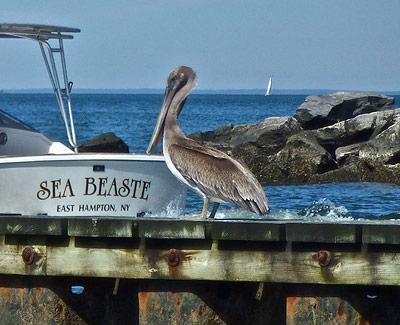Nature Notes: Know Your Pelicans

The migration back to the city is under way. The migration south is under way. Not only are birds leaving us, but fish are going around Montauk Point on their way to warmer waters, dragonflies, and butterflies are moving off, whales, dolphins, and marine turtles are paddling south. In a few weeks the Canada geese and other waterfowl will be honking and quacking as they set in from northern breeding grounds, the seas off Montauk Point will be covered with the dark forms of scoters, geese will be settling into Hook, Georgica, and Wainscott Ponds, the leaves will turn, potatoes will be dug from the fields, and it will be fall.
Not all migration is toward the equator, however. Mute swans move less than a mile, sometimes on foot, from breeding ponds to larger bodies of water, where they congregate to spend the winter in each other’s company. This is also the season for upshoots from the south and inshoots from the west.
There has been an immature black tern feeding in the inlet of Three Mile Harbor for several weeks. Could it be related by birth to the adult black tern that used to visit Sammy’s Beach and the harbor annually in the spring prior to the year 2000?
A visitor from the south that we are seeing more and more of each year has set down on the jetties at the north end of Lake Montauk and has been entertaining the folks eating at Gosman’s famous restaurant for a week and a half or more. You might have noticed it yourself and identified it correctly as a brown pelican. Vicki Bustamante, who lives in Montauk and “feeds” on unusual birds and rare plants, was the first to report it to me. It appeared in the wake of Irene, partially blown into town as it were.
In most cases it’s a few brown pelicans together, but this one came as a loner. It has been sharing Lake Montauk inlet’s rich pisciculture with a band of double-crested cormorants, with which it is equally adept at catching fish. It has a singular advantage over the other: its gular fold, which identifies the pelican to the layman at a great distance. The cormorant can gape its mouth from side to side to put down something wide such as a fluke or flounder. The pelican can do the same thing, but also collect more than one fish at a time in that pouch hanging from its bill.
There was a time in the 1960s when brown pelicans in the United States had been reduced to a few thousand individuals. Like the ospreys, they were victimized by DDT and other chlorinated hydrocarbon pesticides that entered the waters from farmlands or were sprayed into them by moswere banned by the Environmental Protection Agency shortly after President Richard Nixon and Congress created it, the pelicans began to come back on both coasts. Now, along the Gulf Coast and south Atlantic coast, they are almost as common as gulls, and much more abundant than their cousin the white pelican of the Midwest and Southwest.
In the air pelicans can be easily identified, not only by their gular pouch and their large size, but they fly in a particular formation that is rarely seen in other birds. They fly in a line, follow-the-leader like, low over the water. They seem to know where they are going. They flap and glide, conserving energy, the way birds do when they set their wings and sail along. As soon as the lead bird stops flapping, the second in rank sets its wing horizontally, followed by the third, then the fourth, and so on in precise military fashion. As soon as the lead bird stops gliding and starts flying, the trailing birds in tight formation, one by one, take up the beat, until the very last is flapping along to keep up with the others, all the while keeping in a straight line at the same elevation above the water, equally separated in space and time from each other.
By the end of this decade we shouldn’t be surprised to see a pelican or two each summer day visiting the Hamptons, and perhaps, near the end of summer, fledglings in tow, learning how to flap and glide with precision, like their parents.
